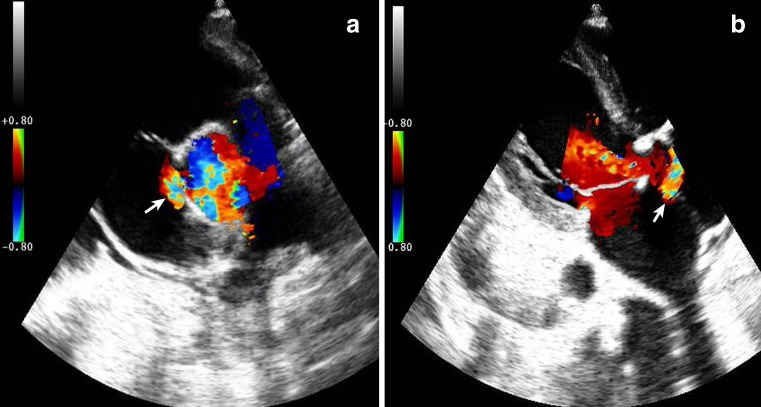Sinus of Valsalva aneurysm (SVA) is a rare cardiac anomaly and comprises less than 1% of congenital cardiac defects. It can be congenital or acquired. Echocardiography and cardiac magnetic resonance imaging are noninvasive imaging procedures primarily used for diagnosis.
A 47-year-old patient with a history of asthma was admitted through the emergency department which dyspnoea that had started three weeks previously. Physical examination revealed a regular pulse of 106 beats/min. The blood pressure was 110/60 mmHg. He had a grade 5 continuous murmur and bilateral basal rales on physical examination.
Transthoracic echocardiography was performed and showed a slightly dilated right ventricle in the presence of a ruptured SVA left-to-right shunt from the aorta into the right atrium in association with a bicuspid aortic valve (Fig. 1). We had planned surgery but the patient refused the operation. SVA is an uncommon condition and association with bicuspid aortic valve has been reported previously [1, 2]. Transoesophageal echocardiography and magnetic resonance imaging are useful for diagnosis and may help to delineate the anatomy further. Unfortunately, the patient did not give permission for further evaluation and treatment.
Fig. 1.
Parasternal short- (a) and long-axis (b) view showing a ruptured sinus of Valsalva (arrow) with a bicuspid aortic valve
Acknowledgments
Open Access
This article is distributed under the terms of the Creative Commons Attribution Noncommercial License which permits any noncommercial use, distribution, and reproduction in any medium, provided the original author(s) and source are credited.
References
- 1.Dong C, Wu QY, Tang Y. Ruptured sinus of Valsalva aneurysm: a Beijing experience. Ann Thorac Surg. 2002;74:1621–4. doi: 10.1016/S0003-4975(02)03987-5. [DOI] [PubMed] [Google Scholar]
- 2.Aggarwal SK, Iyer VR. Ruptured sinus of valsalva with bicuspid aortic valve. Clin Cardiol. 2009;32:97–98. doi: 10.1002/clc.20103. [DOI] [PMC free article] [PubMed] [Google Scholar]



